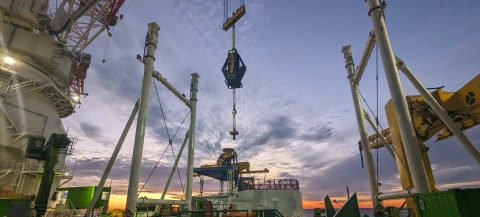
Seaqualize completes offshore transfer lifts for Vineyard Wind 1
Seaqualize, a Dutch heave compensation specialist, has successfully executed the world’s first offshore transfer lifts of wind turbine components from a heaving supply vessel. The Heave Chief 1100, Seaqualize’s newly developed offshore lifting device, is being deployed by DEME Offshore US.
To ensure the year-round installation of Halliade X 13 MW turbines for the Vineyard Wind project, the Heave Chief 1100 is being used in conjunction with the feeder barge solution, developed by DEME Offshore US in collaboration with Barge Master, Foss Maritime and Seaqualize. The technology is supported by operators and equipment from GE Renewables and is expected to form the first commercial-scale wind farm installation project in the USA.
Seaqualize is responsible for executing the fast lift from the barge to the installation vessel while compensating for heave motions. DEME Offshore is the first contractor embarking on such an operation, by transporting and installing wind turbine generators for the Vineyard Wind 1 project led by Avangrid and CIP, located off the coast of Massachusetts. Each turbine will be transported in separate components from the supply harbour to DEME’s installation vessel Sea Installer.
Working in adverse conditions
Seaqualize is a company that develops and operates inline Balanced Heave Compensators. They have created a next-generation lifting tool specifically designed for heavy lifting and in-air active load control. Their latest model, HC1100, is capable of compensating and quickly lifting up to 1100 mT, making it ideal for balancing turbine components of the 15MW generation.
Normally, such lifts would require extremely flat seas. Re-hits with the heaving barge deck or shock loads to the lifting crane could cause serious damage. However, over the first set of lifts made so far, the HC1100 has shown that it can seriously increase the workability of such operations. This machine can continue to fully compensate heave motions up to 3.5m, allowing lifting to continue while it does so. The first lifts have shown that it can fast-lift full loads at speeds of over 70cm/s (42 m/min).
For the tall tower sections of up to 70m high, two separate systems by Barge Master further compensate pitch and roll motions. The HC1100 allows for flexibility in the planning of the operation. Weather conditions can impact the timing and order of the lifting sequence. For offshore crews, it is helpful to have a machine on board that is ready within minutes and can easily switch between varying loads or types of operation while remaining in the crane hook. Besides fast-lifting turbine components, the HC1100 is also used to carefully place delicate component frames back onto the supply vessel for the return trip, which is required for the next load out. This requires the machine to actively follow the motions of that barge vessel, thus greatly reducing set-down speeds.
Read more: Jones Act-compliant feeder system gets to work on Vineyard Wind
Managing Director Gjalt Lindeboom says, “Some will say: ’Haven’t we done floating lifts for years already in the Oil & Gas industry? The answer is ‘yes’, but not at this scale, frequency and with such delicate, standard components. In Oil & Gas, it is not uncommon to wait several days or even weeks to execute one single safe floating transfer lift of, for example, a heavy platform top side, or vessel module. It only has to be done once and that is the project. Furthermore, the component is usually engineered and fabricated to withstand any undesired transport, lifting or installation loads, simply by adding protective steel.”

In the Offshore Wind Sector, which is extremely cost-driven and competitive, there are limitations to what can be done. For instance, the Vineyard Wind project requires more than 800 lifts of loads ranging between 10 and 1,000mT, and these lifts need to be completed as quickly as possible. The wind farms that are planned for the upcoming years are sometimes even twice as large. Waiting for the right conditions for each lift can lead to significant delays in getting power from the wind farm, which is not ideal. Additionally, the components must be lifted as designed and mass-produced, taking into account the 30-year lifetime of generating electricity at sea, rather than the bumpy transfer lifts.
“We are very proud of these first successful fast-lifts and the contract and cooperation with DEME. In addition, the second Seaqualize Heave Chief – the HC750 – is about to start operations this month, on another wind farm installation project ramping up in the US. We are currently planning the production of additional machines to support projects in 2024 up to 2026. Combined with the first successful results from Vineyard Wind, this cements Balanced Heave Compensation as the way to go for safe and efficient offshore feeder lifts. Floating offshore heavy lifting has many complex problems. For now, it’s been shown that ‘heave compensation’ is not one of them…anymore,” Lindeboom said.
You just read one of our premium articles free of charge
Want full access? Take advantage of our exclusive offer




